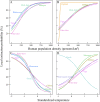Historical records reveal the distinctive associations of human disturbance and extreme climate change with local extinction of mammals
- PMID: 31481618
- PMCID: PMC6754601
- DOI: 10.1073/pnas.1818019116
Historical records reveal the distinctive associations of human disturbance and extreme climate change with local extinction of mammals
Abstract
Accelerated anthropogenic impacts and climatic changes are widely considered to be responsible for unprecedented species extinction. However, determining their effects on extinction is challenging owing to the lack of long-term data with high spatial and temporal resolution. In this study, using historical occurrence records of 11 medium- to large-sized mammal species or groups of species in China from 905 BC to AD 2006, we quantified the distinctive associations of anthropogenic stressors (represented by cropland coverage and human population density) and climatic stressors (represented by air temperature) with the local extinction of these mammals. We found that both intensified human disturbances and extreme climate change were associated with the increased local extinction of the study mammals. In the cold phase (the premodern period of China), climate cooling was positively associated with increased local extinction, while in the warm phase (the modern period) global warming was associated with increased local extinction. Interactive effects between human disturbance and temperature change with the local extinction of elephants, rhinos, pandas, and water deer were found. Large-sized mammals, such as elephants, rhinos, and pandas, showed earlier and larger population declines than small-sized ones. The local extinction sensitivities of these mammals to the human population density and standardized temperature were estimated during 1700 to 2000. The quantitative evidence for anthropogenic and climatic associations with mammalian extinction provided insights into the driving processes of species extinction, which has important implications for biodiversity conservation under accelerating global changes.
Keywords: climate change; conservation; human disturbance; local extinction; mammals.
Copyright © 2019 the Author(s). Published by PNAS.
Conflict of interest statement
The authors declare no conflict of interest.
Figures




References
-
- Pereira H. M., et al. , Scenarios for global biodiversity in the 21st century. Science 330, 1496–1501 (2010). - PubMed
-
- Yap T. A., Koo M. S., Ambrose R. F., Wake D. B., Vredenburg V. T., BIODIVERSITY. Averting a North American biodiversity crisis. Science 349, 481–482 (2015). - PubMed
-
- Rahbek C., Colwell R. K., Biodiversity: Species loss revisited. Nature 473, 288–289 (2011). - PubMed
Publication types
MeSH terms
LinkOut - more resources
Full Text Sources
Medical

